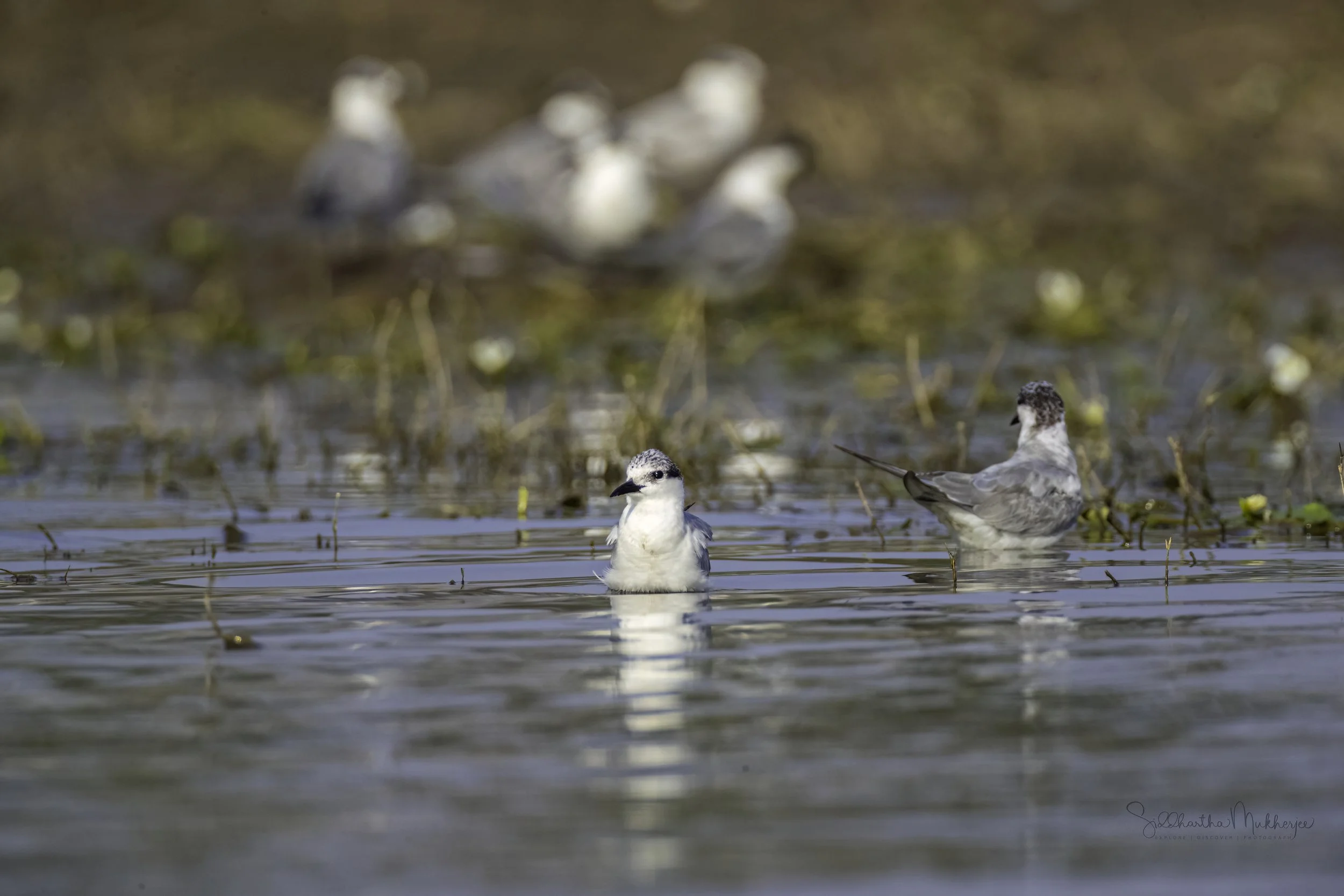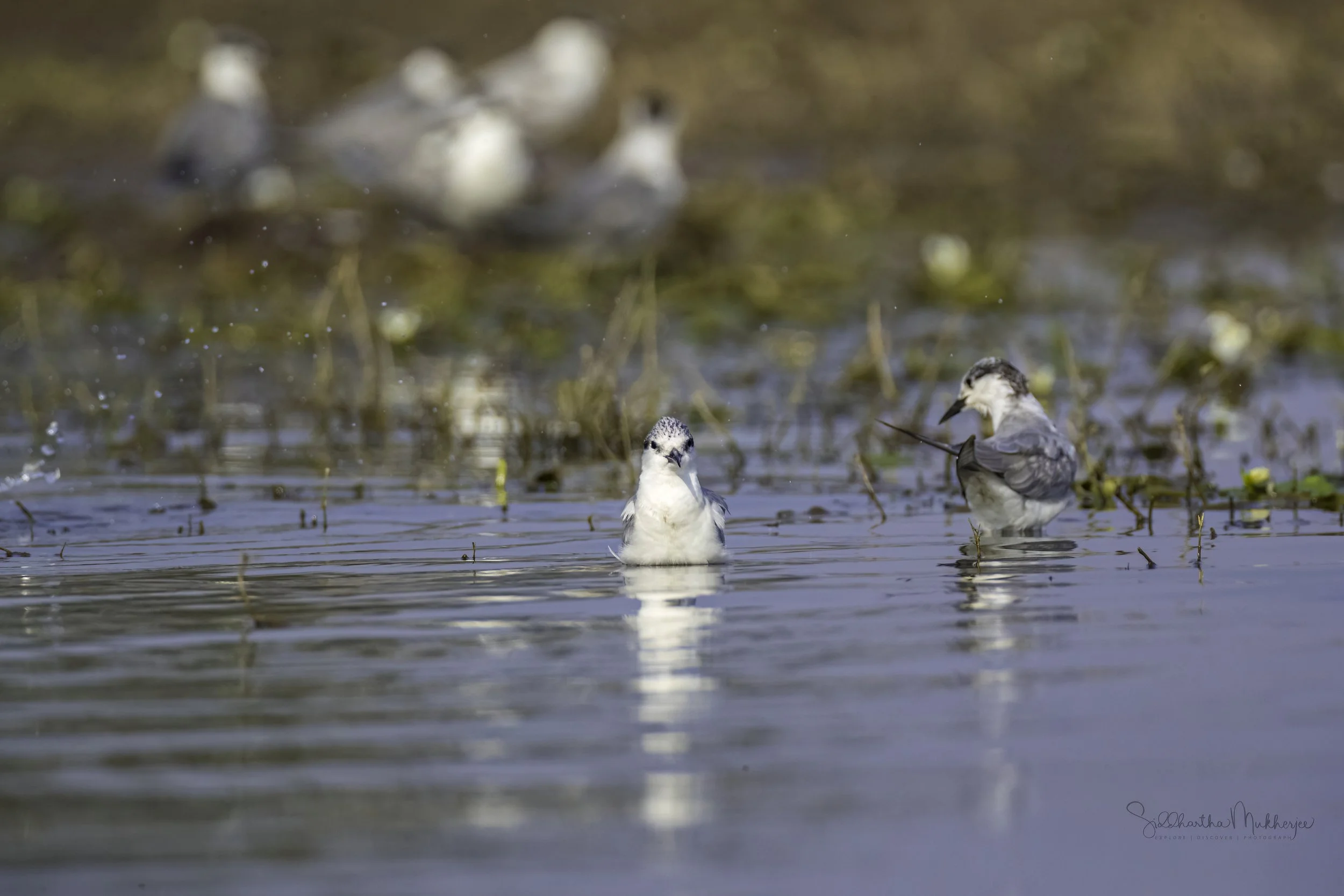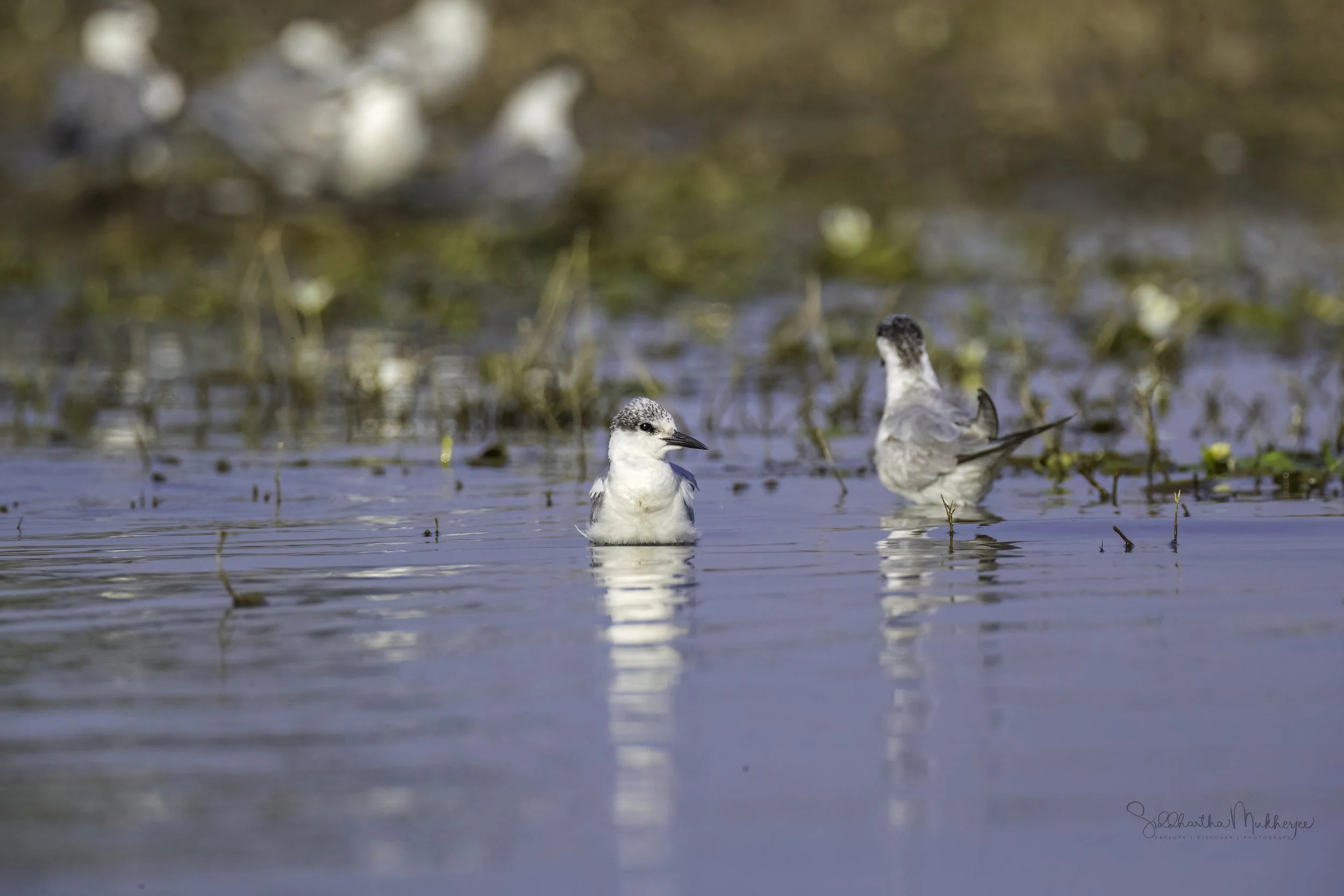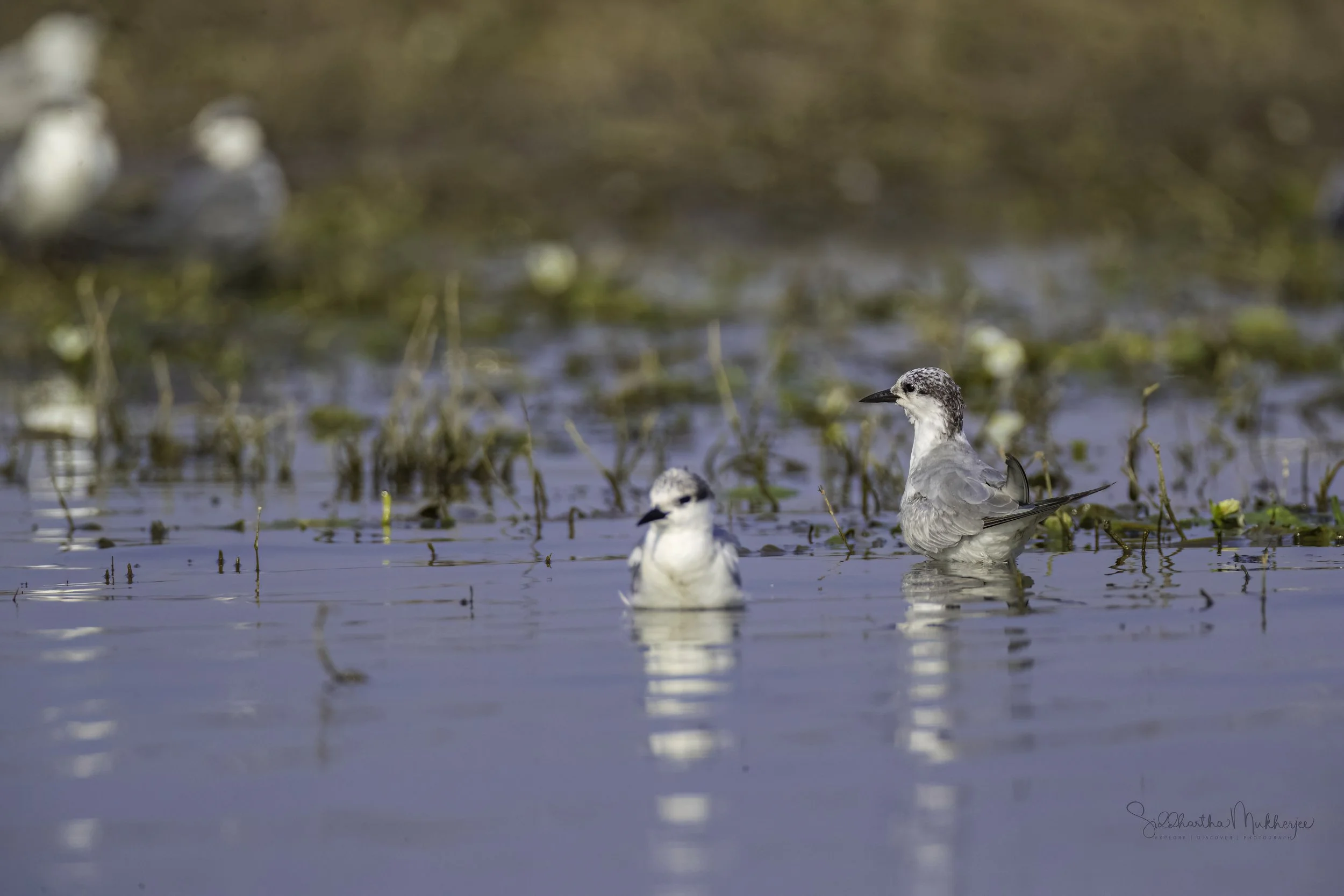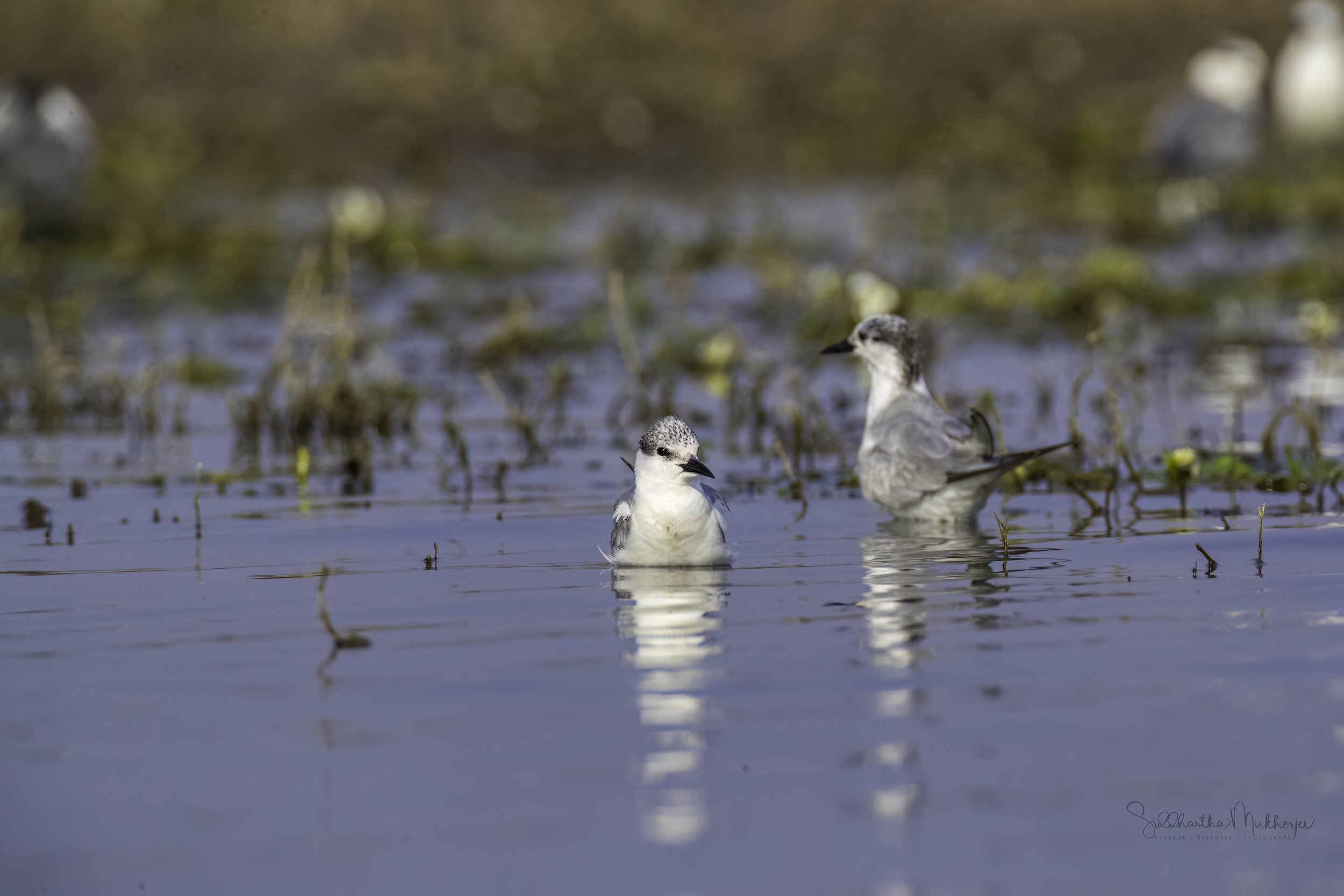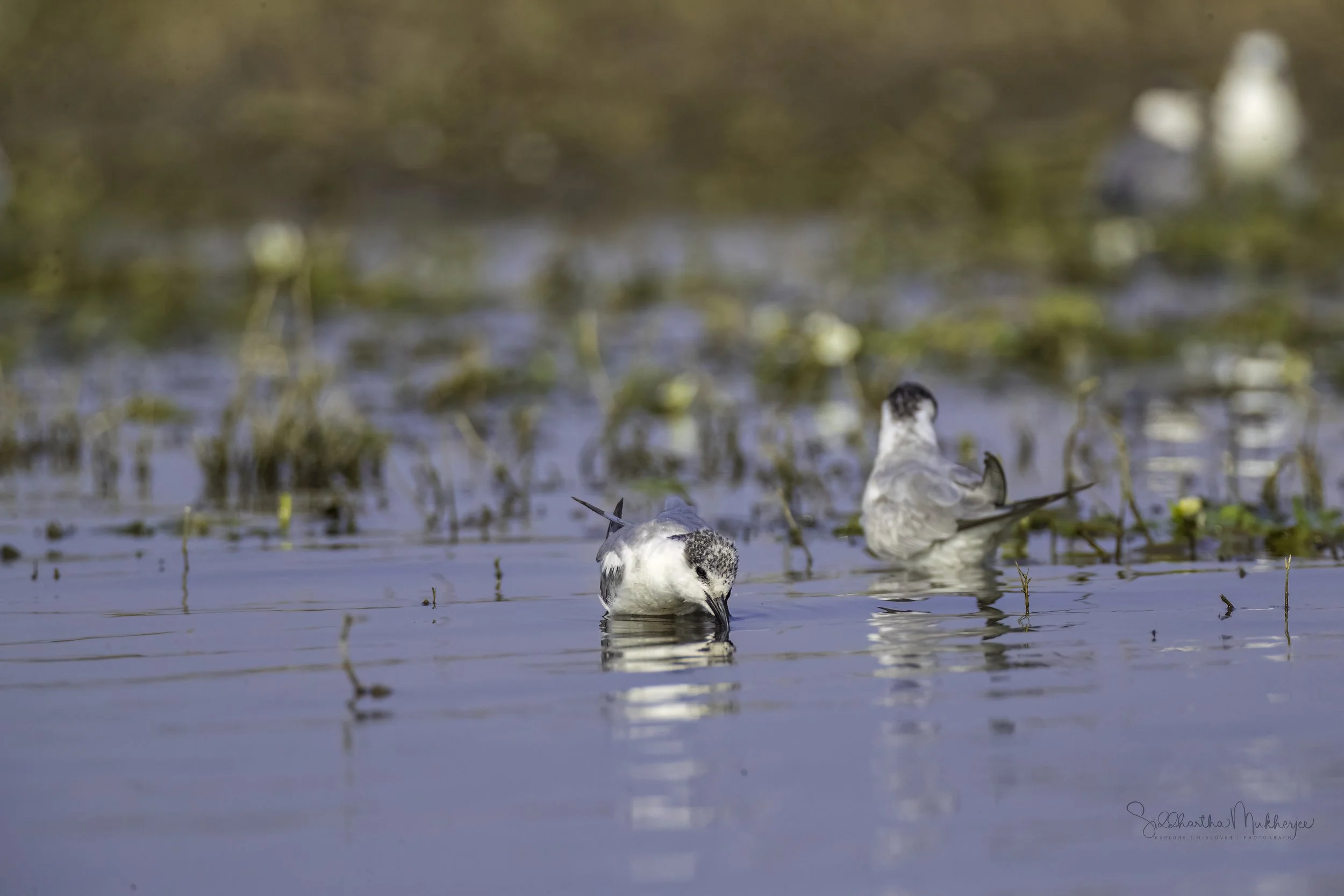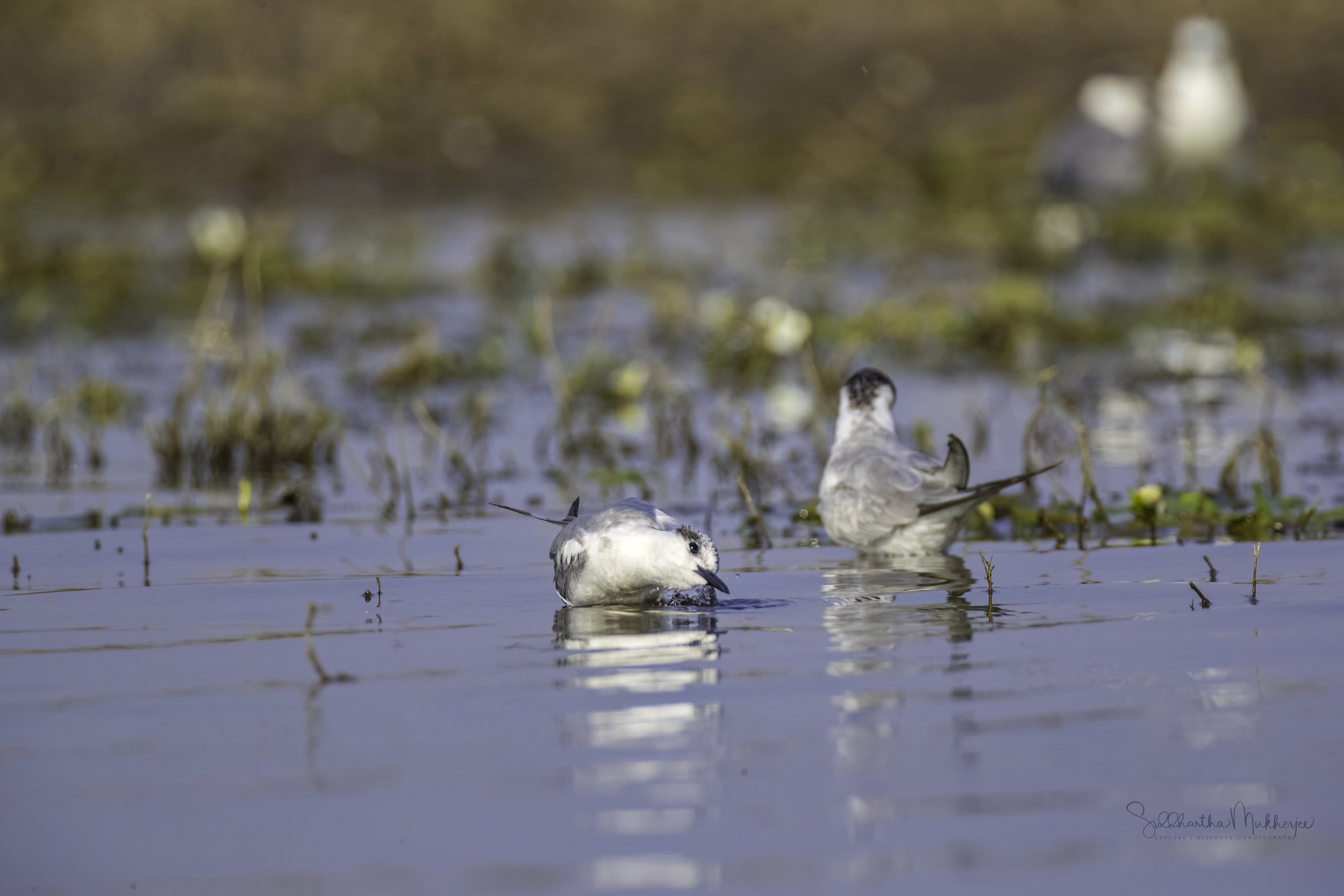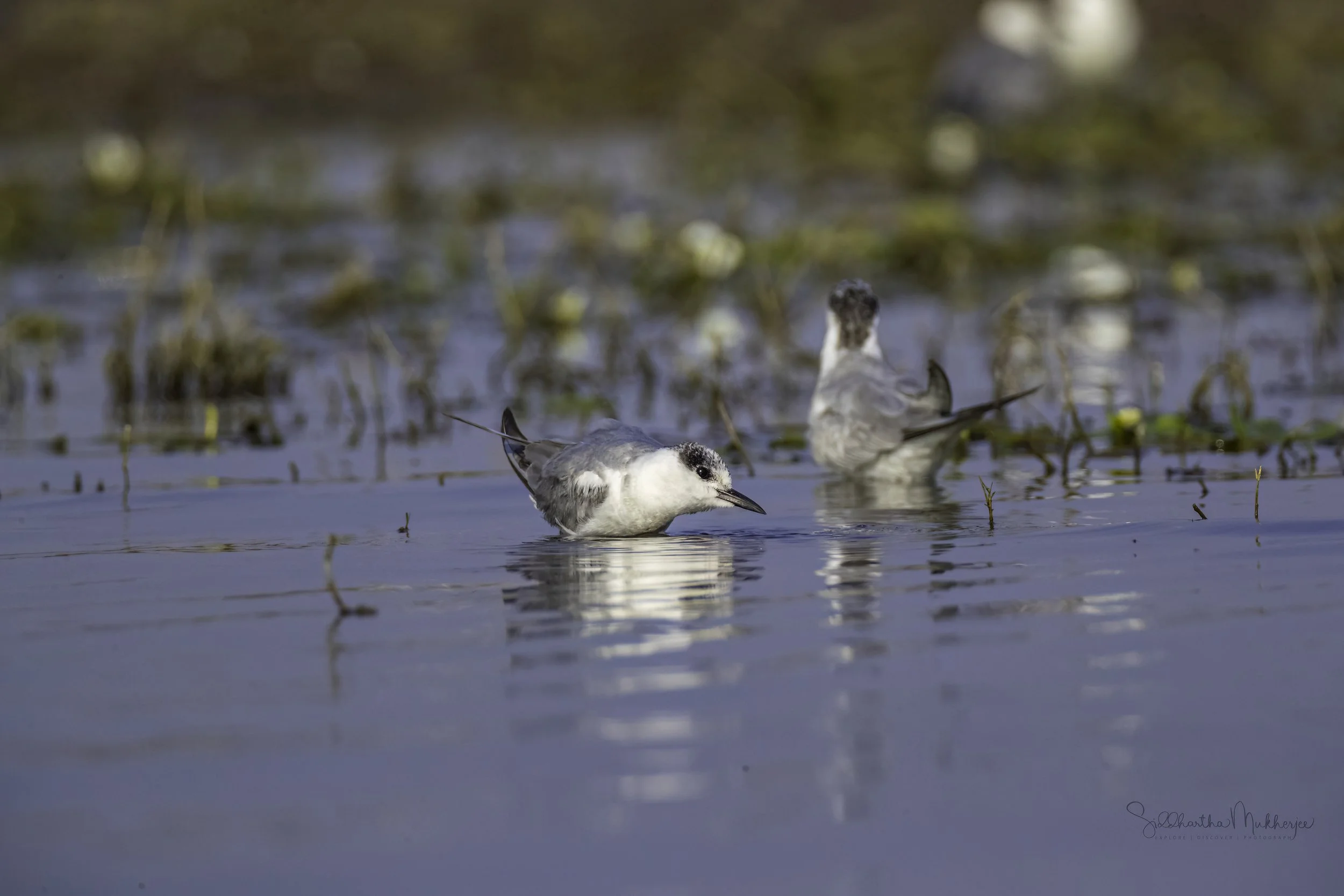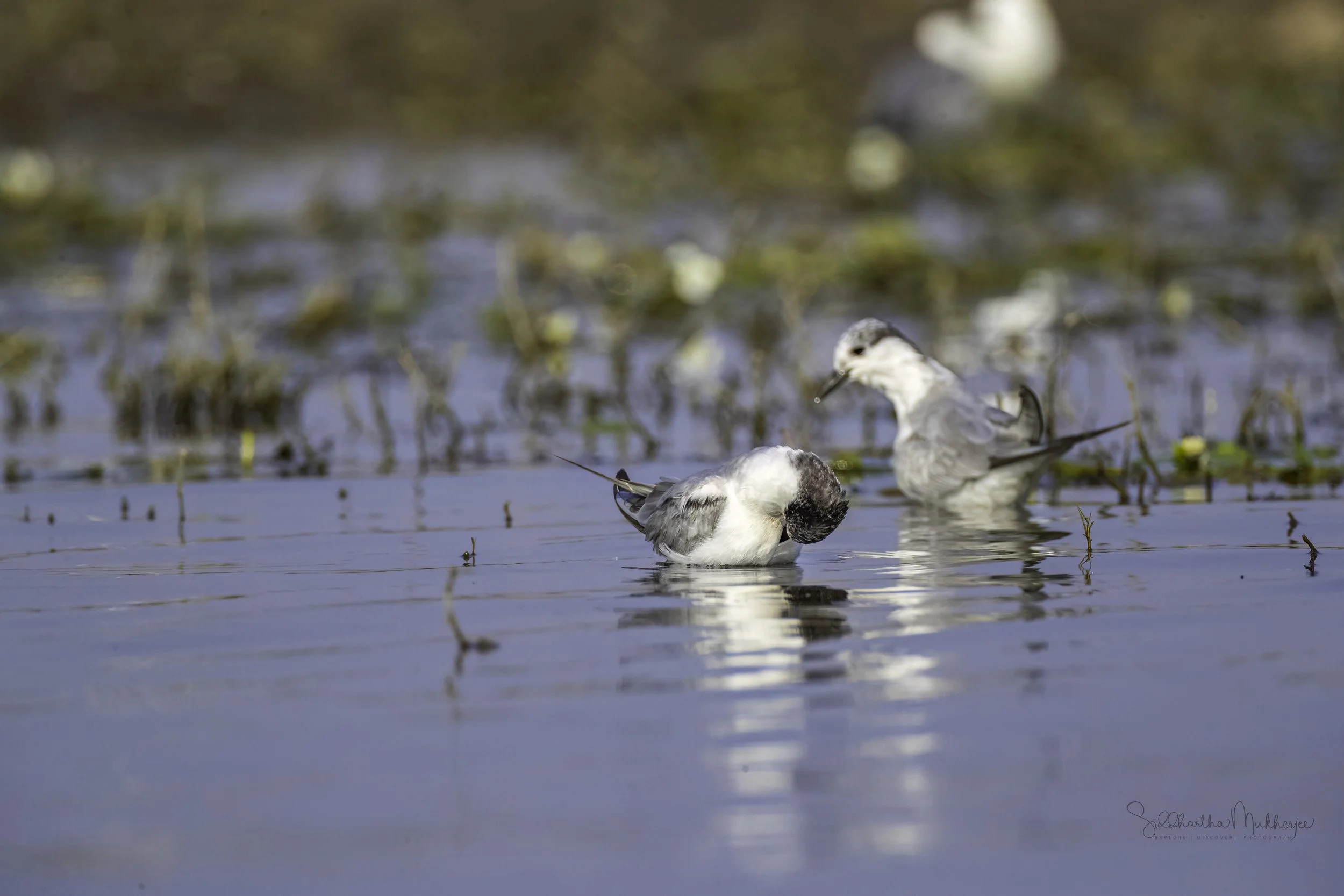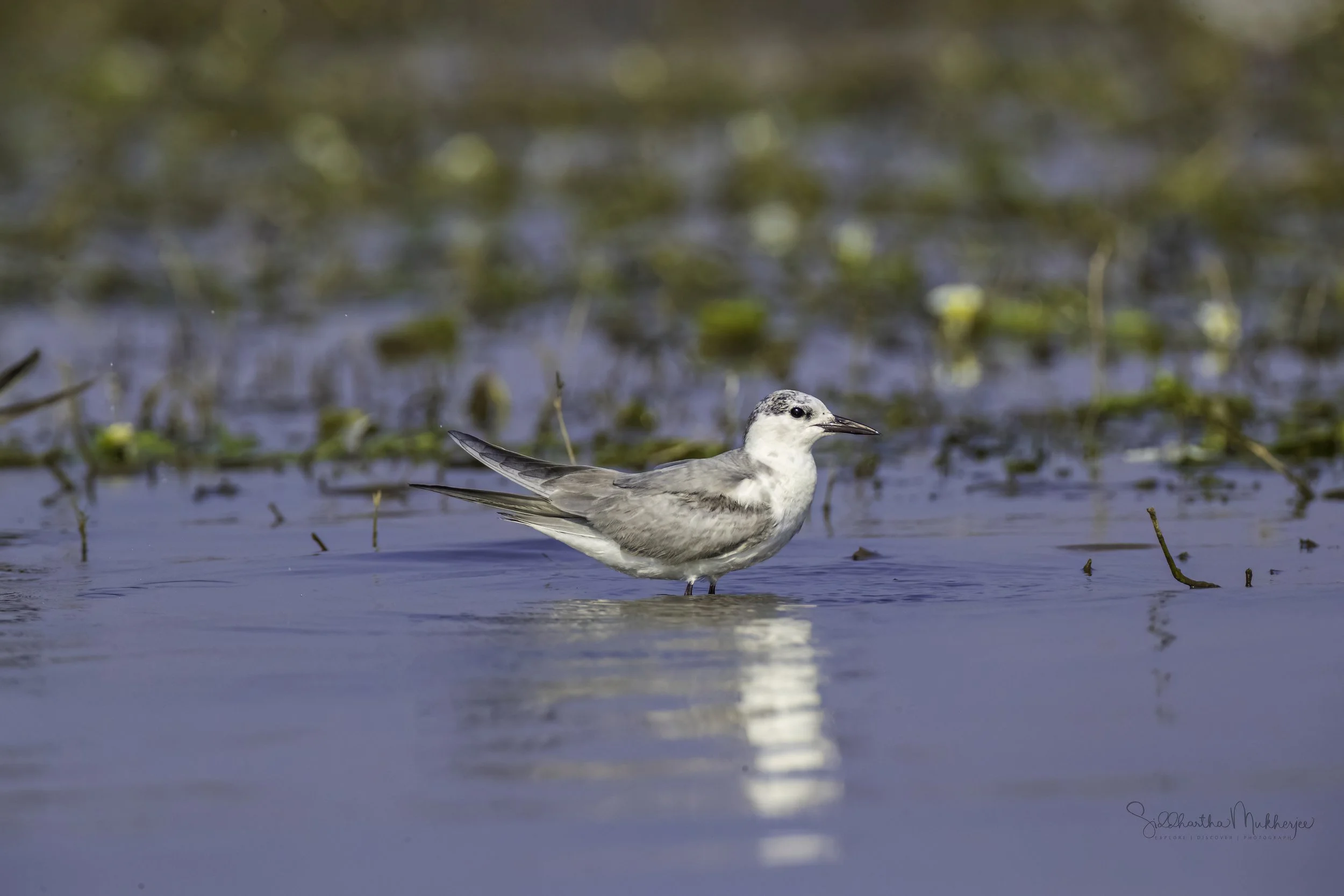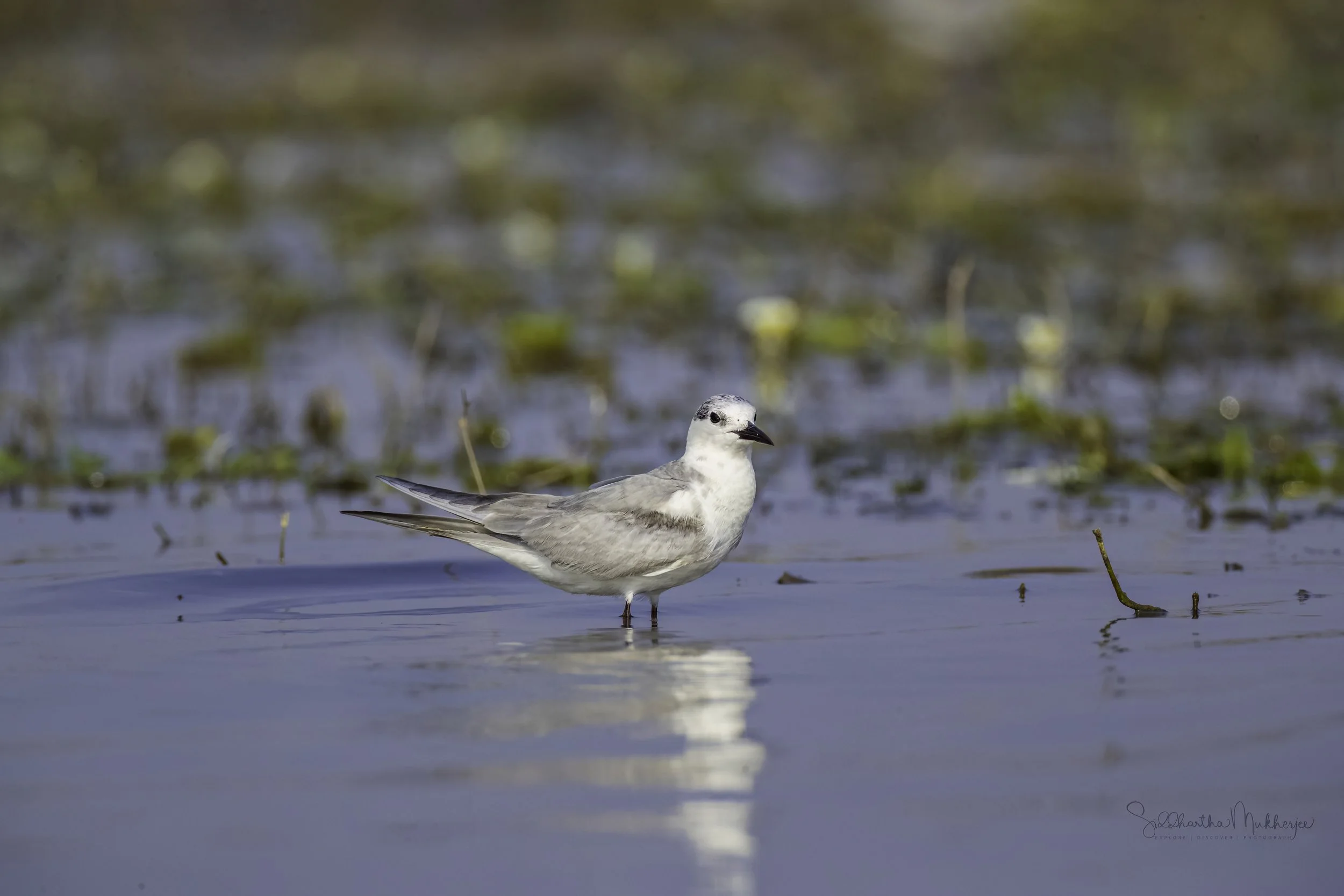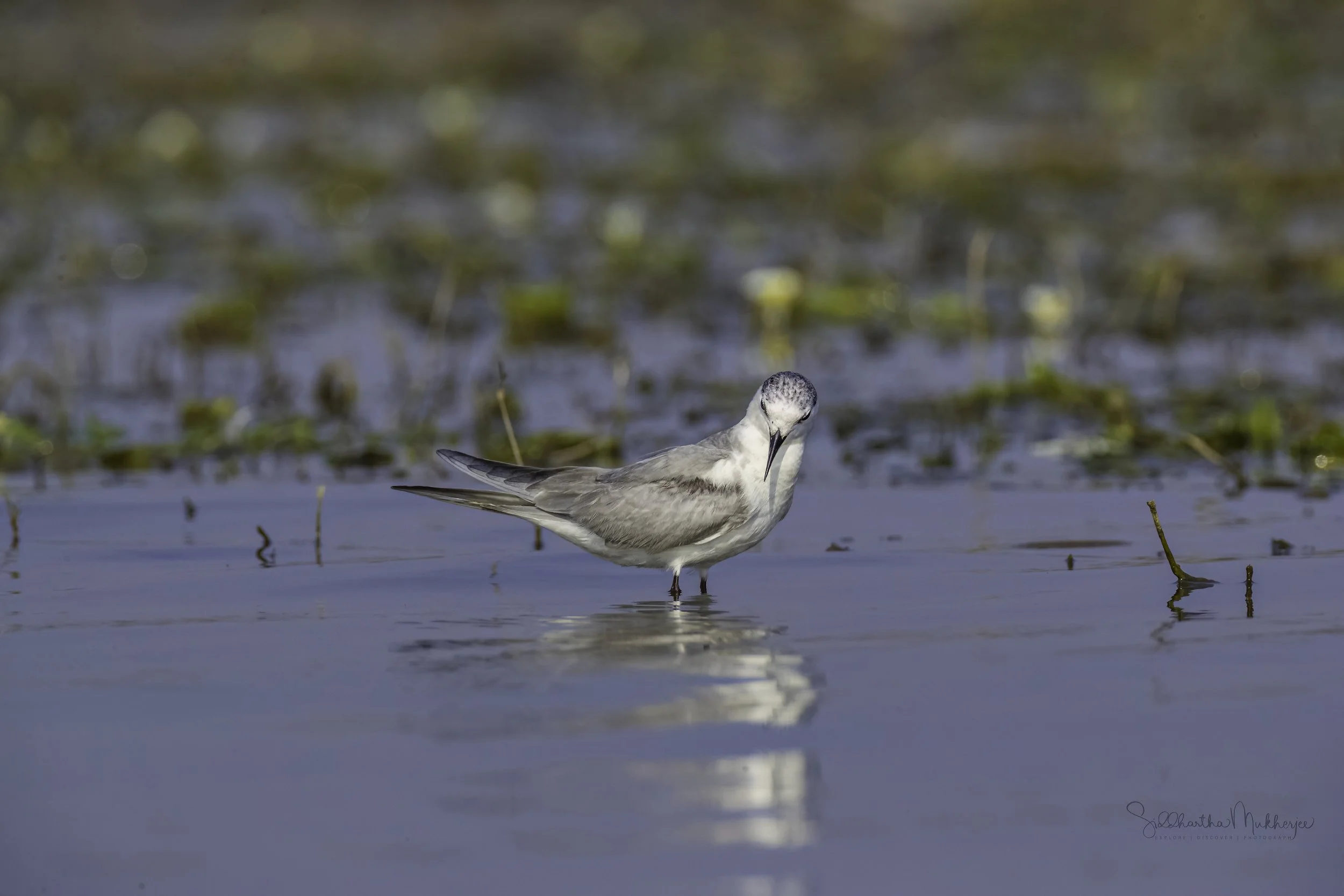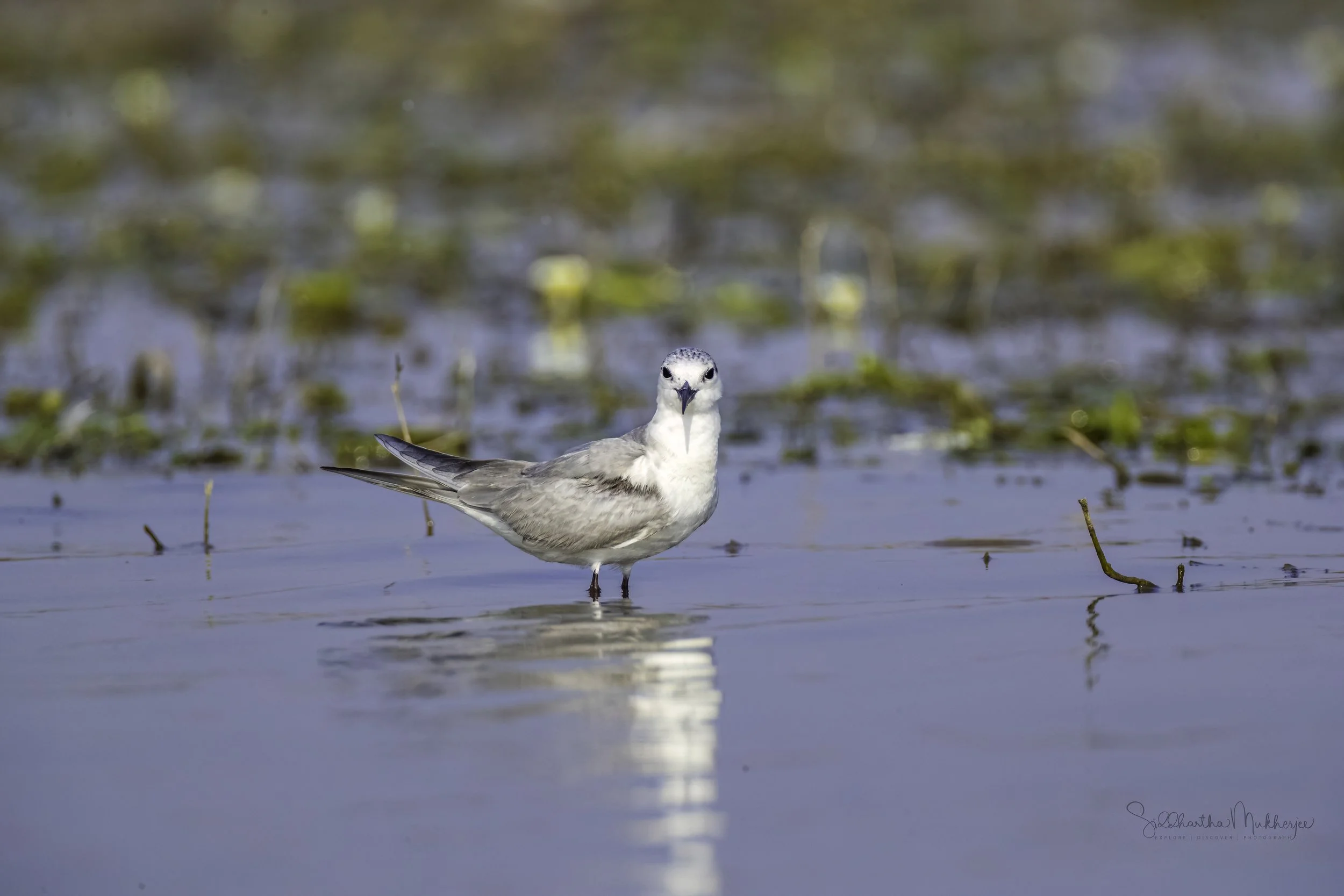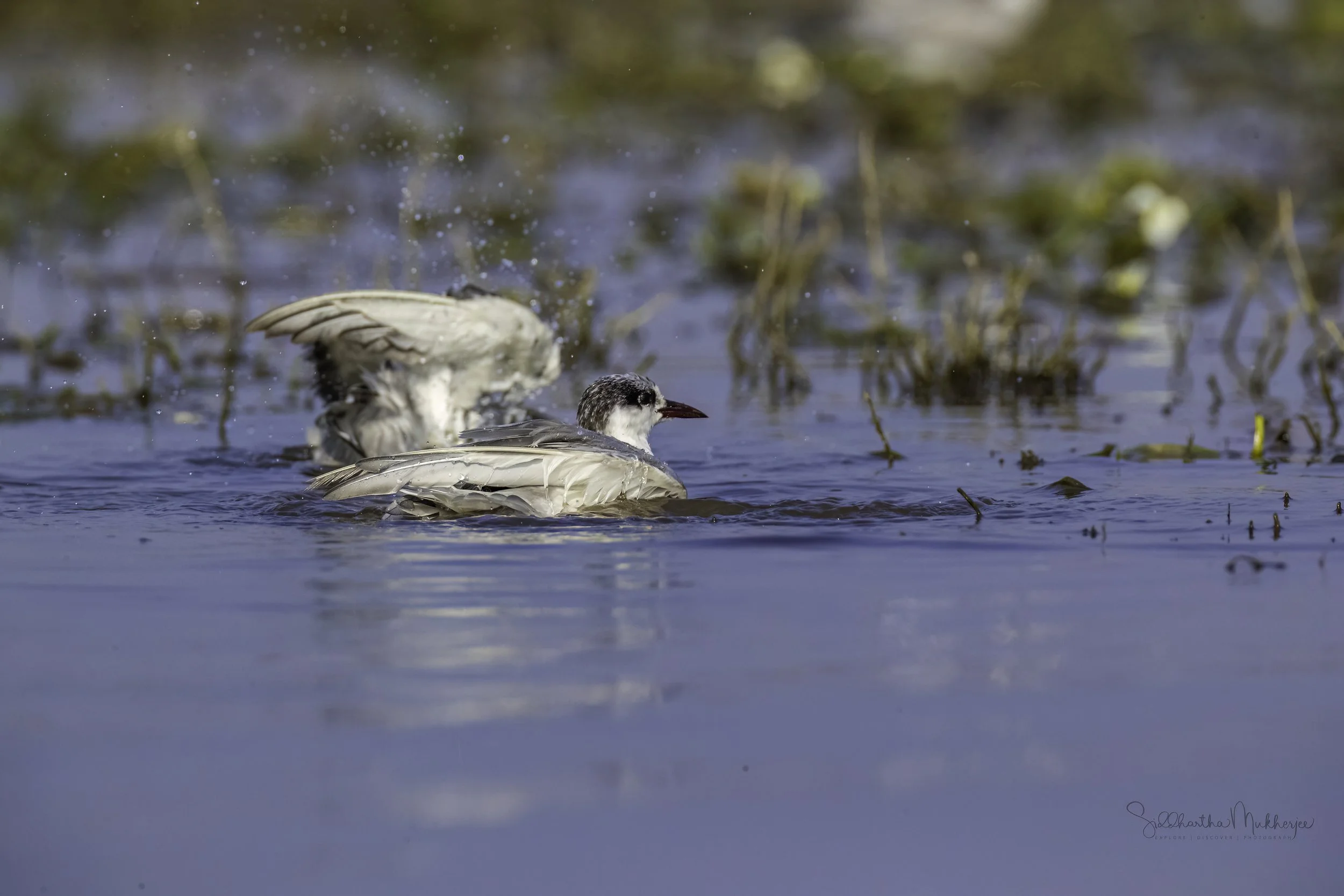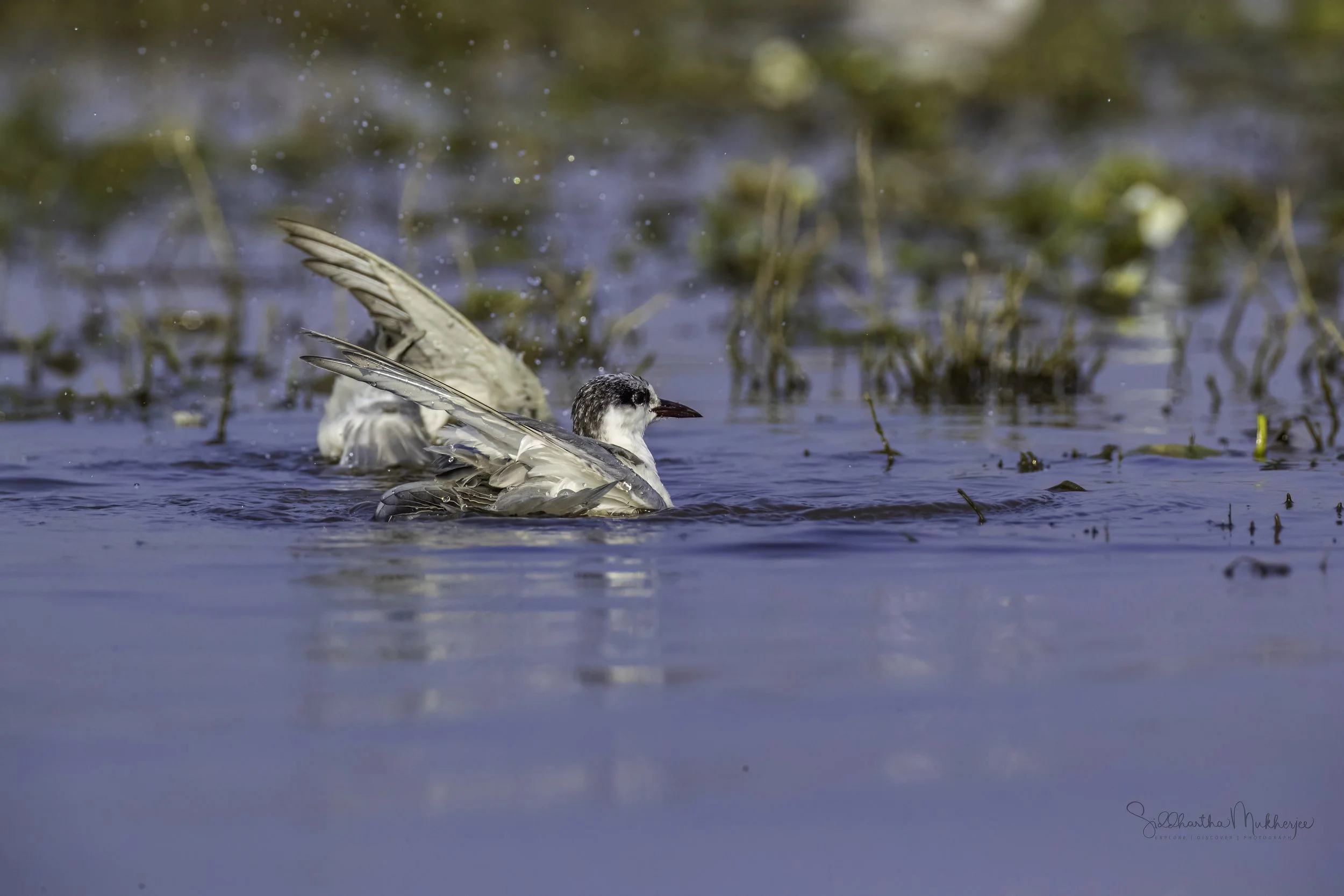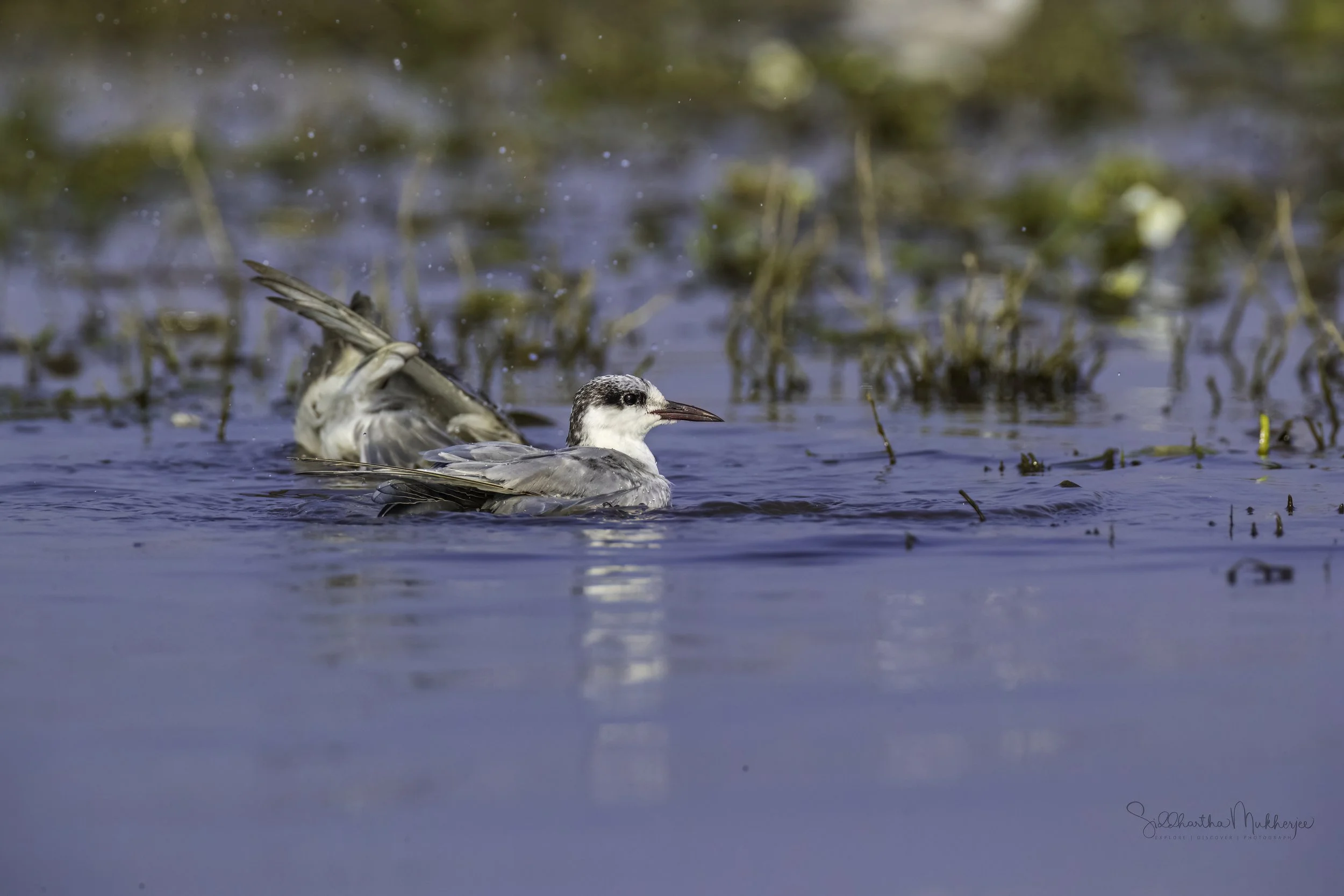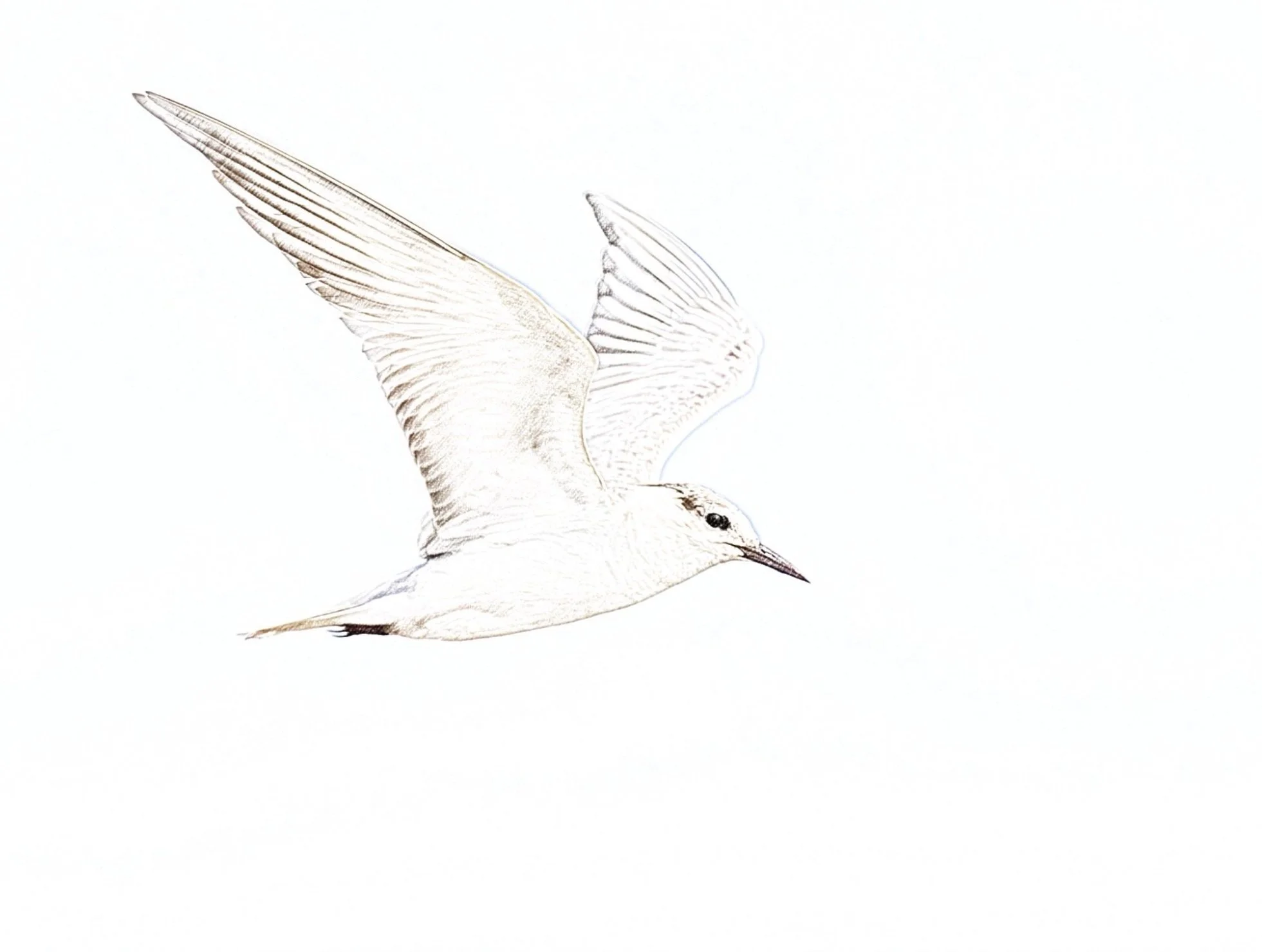Whiskered Tern
Chlidonias hybrida
Bhigwan Bird Sanctuary - Ujni Backwaters, Kumbhargaon
To the south of Bhigwan, bereft of any hills, lie the wide Ujni backwater wetlands. A shallow waste water reserve formed by the discharge of water from the Pune region dams like Panshet, Pawna, Khadakwasla, Varasgaon, Temghar, etc. This semi waste water has created an excellent wetland based ecosystem supporting a large variety of water birds, both endemic and migratory, and also helped with the local agriculture. Nearly 300 species of endemic and migratory birds have been recorded here. The rainfall in the Pune region decides the water level in Ujni dam. Lesser the water, the shallower it is and therefore more birds make it their home in the winter.
Surrounding this lush ecosystem are the rich grasslands and fertile farms home to an impressive list of birds, mammals and reptiles. The area around these backwaters are also unique with rich farmlands and dry deciduous scrub forest with interspersed grasslands. Home to an impressive list of birds, mammals and reptiles they protect many mammals like the Chinkara, the Indian Mongoose, the Near Threatened Striped Hyena, Endangered Indian Grey Wolf & Indian/ Bengal Fox and are also popular for grassland birds and many birds of prey, including some magnificent eagles & harriers. My trip this time was focused only a few species like the Striped Hyena, Indian Grey Wolf and Jungle Cat. On our way back into the grasslands from the backwaters after spending some time with the Near Threatened Great Thick-knee and the Kentish Plover I came across this Whiskered Tern in the Ujni Backwaters.
From Right: Ganesh, Sandip Nagare & yours truly
But these water birds aren’t the only ones there, there are some magnificent eagles and harriers like the Endangered Steppe Eagle, the Vulnerable Greater Spotted Eagle, the rare and Vulnerable Eastern Imperial Eagle & the Pallid Harrier, Montagu’s Harrier & Eurasian Marsh Harrier. Apart from these there are other spectacular species like the Short-eared Owl, Spotted Owlets & the Indian Courser inhabiting the grasslands.
During my time here I was hosted by & had the expert help of Sandip Nagare and his team of knowledgeable guides from the Agnipankha Bird Watcher group, especially Ganesh Bhoi, who went out of their way to ensure I had fantastic opportunities to explore, discover, observe & photograph my target species on this trip like the Near Threatened Striped Hyena. As always, I stayed at Sandip’s homestay and once again had the added pleasure of indulging in delectable home cooked food.
Read about my birds from Kumbhargaon & the Bhigwan Bird Sanctuary here and watch the videos on my Youtube channel - WildArtWorks.
This time I saw some very alarming signs. The summers of the last two years have been harsh and the rains have been scanty leading to extensive evaporation and receding of the waterfront. My friend and local guide, Ganesh, said that the backwaters have receded almost two kilometers from where they used to be. This exposed land is now used for cattle grazing and some degree of farming.
Ujni Backwaters, Bhigwan Bird Sanctuary
The Ujni or Ujjani Dam, also known as Bhima Dam or Bhima Irrigation Project, on the Bhima River, a tributary of the Krishna River, is an earth-fill cum Masonry gravity dam located near the Ujjani village of Madha Taluk in the Solapur district of the state of Maharashtra in India. The Bhima River, which originates in Bhimashankar of the Western Ghats, and forms the Bhima Valley with its tributary rivers and streams, has twenty-two dams built on it of which the Ujjani Dam is the terminal dam on the river and is the largest in the valley that intercepts a catchment area of 14,858 km² (which includes a free catchment of 9,766 km²). The construction of the dam project including the canal system on both banks was started in 1969 at an initial estimated cost of ₹400 million and when completed in June 1980 the cost incurred was of the order of ₹3295.85 million.
The reservoir created by the 185 feet high earth cum concrete gravity dam on the Bhima River has a gross storage capacity of 3.320 km³. The annual utilisation is 2.410 km³. The project provides multipurpose benefits of irrigation, hydroelectric power, drinking, and industrial water supply and fisheries development. The irrigation supplies benefit 500 km² of agricultural land, particularly in the Solapur district. Water supplied from the reservoir to irrigate agricultural areas primarily aims to reduce the incidence of famines and scarcity during drought conditions. The reservoir operation also lessens the threat due to floods to cities such as Pandharpur (an important religious pilgrimage centre for the Hindus). As a result of irrigation facilities, some of the important crops grown under irrigated conditions are sugarcane, wheat, millet and cotton.
This huge reservoir, almost seeming like a sea, is home to hundreds of birds - Flamingos with their slender necks, Egrets, Painted Storks, Ruddy Shelducks and many more. A man-made wetland, these backwaters are a winter sojourn of many migratory birds like the Brown-headed Gulls, Pallas’s Gull & Bar-headed Geese making it a mesmerising spectacle. This reservoir is one of the largest backwaters in India created by the Ujni dam. This life giving and sustaining reservoir fulfils multiple purposes - irrigation for agriculture, particularly in the Solapur district, being the primary one - but it also has rural, urban and industrial activities that are equally consuming.
Presently India has 26 sites designated as wetlands of International Importance according to Ramsar Convention. As far as Maharashtra goes, of its multiple natural and man-made reservoirs, none are designated as a Ramsar site. But according to Ramsar’s important identification criteria of population of migratory birds, the Ujni backwaters are amongst the six important wetlands of Maharashtra hosting around 250 species of migratory and resident birds ranging from the Pied Kingfisher, Kentish Plover, Bar-headed Geese, Common Snipe, Painted Stork, Great Stone-curlew/ Great Thick-knee, Glossy Ibis, Black-headed Ibis, Red-naped Ibis, the list is pretty long.
With such a blessed habitat harbouring many species of flora and fauna, this wetland has tremendous benefits to the villages around it. Sufficient water for agriculture, livelihoods to many through fishing and tourism, flood control and shoreline stability are some of the aspects this wetland caters to. Though created strategically for economic development, today, the value of these wetlands function far beyond the scope of any instrument of economic growth.
But the modern day demands on this resource are tremendous. Cash crops requiring huge irrigation, unmonitored use of pesticides, untreated and excessive sewage and industrial waste disposals, uncontrolled urban growth and the changing mindsets of people for newer lifestyles are slowly and steadily affecting this huge wetland. Decline in the fish density in the major tributaries of River Krishna, increase in exotic weed species in water are some of the indicators of quality degradation of the wetland recorded by researchers. This isn’t the only threat to this spectacular habitat and its wildlife but it also has long term adverse effects on the present and future human population who are consumers of this wetland in the various ways they utilise it.
The conservation of such a large reservoir isn’t a simple task. It requires judicious water usage for local, agricultural and industrial purposes, advocating advanced irrigation technologies to avoid and minimise wastage and banning diversions of water for non-priority purposes can be some of the large-scale measures possible with equal participation of the Government and people alike. Conservation awareness among the local communities for wetlands and its flora-fauna can help in a long run.
On a smaller scale the villagers are doing their bit by consciously avoiding plastic litter, controlled fishing and adopting rowing instead of engines for tourist boats wherever possible. These are some of their simple but effective ways to stop draining these life giving wetlands.
Whiskered Tern
The Whiskered Tern (Chlidonias hybrida) is a tern in the family Laridae. The genus name is from Ancient Greek khelidonios, "swallow-like", from khelidon, "swallow". The specific hybridus is Latin for hybrid; Peter Simon Pallas thought it might be a hybrid of White-winged Black Tern and Common Tern, writing "Sterna fissipes [Chlidonias leucopterus] et Hirundine [Sterna hirundo] natam". This tern is a small, tubby marsh tern with a slightly forked tail. In its breeding plumage it has a black crown and white cheeks and sides of neck (which look like broad white "whiskers" in flight). The upperparts, upperwings and tail are a medium grey, the underparts dark grey to slate grey and the undertail is white with the underwings mainly white. The eye is brown and the bill and legs are red. In its non-breeding plumage (the photos you see here), Whiskered Terns are similar to the breeding adults except for the underparts which are white, the forehead is white and the dark crown is streaked white. The lores (area between bill and eyes) and ear coverts are black while the bill and legs are also blackish. Note the rather stout bill (albeit thinner than Gull-billed Tern) and square tail compared to the Common, Roseate, and Arctic Terns. It feeds by picking from the surface, not splash-diving like typical terns. These terns are common around wetlands, lakes, and rivers. Young birds have a pale grey back, rump and upper wings, heavily mottled medium-brownish grey, especially along leading edge of inner wing, and the tail is pale grey, edged black. The Whiskered Tern is also known as the Marsh Tern or Black-fronted Tern. The sexes are similar. The Whiskered Tern in non-breeding and juvenile plumage can be confused with the non-breeding and juvenile forms of the White-winged Black Tern, (Chlidonias leucopterus), which is slightly smaller, slimmer and more compact. The Whiskered Tern has a slightly forked tail, appearing square-cut at the tip. This is only the second tern I have blogged thus far - the first being the rare Black-naped Terns of the Loyang Rock.
The size, black cap, strong bill (29–34 mm in males, 25–27 mm and stubbier in females, with a pronounced gonys) and more positive flight recall the Common or Arctic Tern, but the short, forked-looking tail and dark grey breeding plumage above and below are typically marsh tern characteristics. The summer adult has white cheeks and red legs and bill. The crown is flecked with white in the juvenile, and the hindcrown is more uniformly blackish, though in the winter adult this too is flecked with white. The black ear-coverts are joined to the black of the hindcrown, and the space above is mottled with white, causing the black to appear as a C-shaped band. The sides of the neck are white; this sometimes continues across the nape. The collar is less sharply defined. All through the year the rump is pale grey. In the juvenile, the mantle has a variegated pattern. The feathers of the back and scapulars are dark brown, with prominent broad buff edgings and often subterminal buff bars or centers. There is usually an admixture of new gray feathers, especially on the mantle, quite early in the fall. The mantle is silvery-gray in the adult. In winter, the forehead becomes white and the body plumage a much paler grey. Juvenile whiskered terns have a ginger scaly back, and otherwise look much like winter adults. The first winter plumage is intermediate between juvenile and adult winter, with patchy ginger on the back.
The call is a characteristic “krekk”.
The whiskered tern eats small fish, amphibians, insects and crustaceans.
This bird has a number of geographical races, differing mainly in size and minor plumage details.
Chlidonias hybrida hybrida (Pallas, 1811) - Eurasian Whiskered Tern - The nominate breeds in warmer parts of Europe and the Palearctic (northwestern Africa and central and southern Europe to southeastern Siberia, eastern China and south to Pakistan and northern India).
Chlidonias hybrida delalandii (Mathews, 1912) - African Whiskered Tern - Smaller-billed and darker, it is found in east and south Africa
Chlidonias hybrida javanicus (Horsfield, 1821) - Australasian Whiskered Tern - A paler form found from Java to Australia.
The tropical forms are resident, but the European and Asian birds winter south to Africa and the Indian Subcontinent. A tagged whiskered tern was spotted at Manakudi Bird Sanctuary, Kanniyakumari District of Tamil Nadu, India in the month of April 2021. This species breeds in colonies on inland marshes, sometimes amongst Black-headed Gulls, which provide some protection. The scientific name arises from the fact that this, the largest marsh tern, show similarities in appearance to both the white Sterna Terns and to Black Tern.
There is no sexual dimorphism in plumage - males may be heavier and larger in all measurements than females, but there are large size range overlaps and both sexes incubate.
This species has an extremely large range and breeds in highly disjunct (separated) populations across southern Europe and Asia, in south-eastern Africa and Madagascar, and in Australia. It occurs as a migrant, vagrant or winter visitor throughout Europe, Africa and Australia. The global population is estimated to number c.300,000-1,500,000 individuals (Wetlands International 2015). The European population is estimated at 66,300-108,000 pairs, which equates to 133,000-215,000 mature individuals (BirdLife International 2015). National population estimates include: c.10,000-100,000 breeding pairs and c.1,000-10,000 individuals on migration in China; c.50-10,000 wintering individuals in Taiwan; < c.1,000 individuals on migration in Korea; c.50-1,000 individuals on migration and < c.50 wintering individuals in Japan and c.100-10,000 breeding pairs and c.50-1,000 individuals on migration in Russia (Brazil 2009). The overall population trend is fluctuating, although some populations are stable and others have unknown trends (Wetlands International 2015). The European population trend is estimated to be increasing (BirdLife International 2015).
Whiskered Terns eat mainly small fish, amphibians, crustaceans, insects and their larvae. There are three main methods of feeding, plunging, dipping and hawking. Plunging involves a hover then dive, with wings raised, from 2 m - 4 m above water. They may also hover and dive to take insects in paddocks. Dipping means that they fly low over water, skimming the surface to take insects from on or just below it. Hawking is taking insects (up to 40mm long) on the wing; Whiskered Terns may hawk over dry plains. The breeding season of the Whiskered Tern is erratic. They breed in loose colonies in large, often temporary, inland swamps and marshes. The nest is a rough raft of vegetation, either floating or moored. The sexes share nest-building, incubation and care of the young. A single brood is usually raised in a season. A whole colony of Whiskered Terns will quickly fly to mob or attack a predator or intruder. The clamour of their cries and the whirling white wings as they swoop down again and again can be a disconcerting experience, and Whiskered Terns will actually strike a person's head with their sharp beaks.
The Whiskered Tern, being mainly migratory and nomadic, prefers shallow terrestrial freshwater wetlands, freshwater swamps, brackish and saline lakes, floodwaters, sewage farms, irrigated croplands and large dams. Northern breeding populations of this species are fully migratory whilst tropical breeders are more nomadic or locally dispersive (del Hoyo et al. 1996). The species breeds from May to early-June (Richards 1990) in monospecific colonies of 10-100 pairs (del Hoyo et al. 1996). After breeding it departs for the wintering grounds from late-July to September, returning again between April and May (Richards 1990). The species sometimes forages singly, but is more common in small groups or larger mixed-species flocks on passage and in the winter (Snow and Perrins 1998). Habitat The species utilises a variety of wetland habitats but shows a preference for freshwater marshlands with scattered pools, particularly where the surrounding vegetation is grazed by cattle or horses (Richards 1990). It frequents inland lakes, rivers, marshes, temporary pans (e.g. in Africa), artificial fish-ponds and drainage-ponds covered with water-lilies (e.g. in Italy) (del Hoyo et al. 1996), swamps, river pools, reservoirs, large dams, sewage-ponds, flooded saltmarshes, arable fields (e.g. in Australia) (Higgins and Davies 1996, del Hoyo et al. 1996) and rice-fields (del Hoyo et al. 1996). In Australia the species also occurs along the coast on estuaries, coastal lagoons, creeks in mangrove swamps (Snow and Perrins 1998) and tidal mudflats (del Hoyo et al. 1996). Diet Its diet consists of terrestrial and aquatic insects (del Hoyo et al. 1996) (e.g. Dytiscidae, adult and larval Odonata, Orthoptera, flying ants (del Hoyo et al. 1996) and mosquitoes (Richards 1990)), spiders, frogs, tadpoles, small crabs (del Hoyo et al. 1996), shrimps (Richards 1990) and small fish (del Hoyo et al. 1996). Breeding site The nest is a heap of aquatic vegetation (Richards 1990, del Hoyo et al. 1996) or dry grass (del Hoyo et al. 1996), placed either on floating and emergent vegetation over water 60-80 cm deep or resting on the bottom of very shallow water
Threats impacting the species
The species suffers nest destruction from the invasive rodent species Myocastor coypus in Italy (Arduin 1997). Within its European range it suffers from the loss of natural wetlands to land reclamation, dry seasons and an increase in drainage schemes (Hagemeijer and Blair 1997), as well as the canalization of rivers (Tucker and Heath 1994). Additionally the following threats have been identified within its European range: increasing tourism and water sports near breeding colonies result in disturbance and the loss of nesting sites (Tucker and Heath 1994) and many nests are lost to adverse weather. It is affected by water quality and so pollution from insecticides and eutrophication are a threat (Martí and Moral 2004); In addition the intensification of fisheries and bycatch in fishing nets are issues (Golemansky 2011). Large numbers of eggs are collected for sale and local consumption in India (this may be causing population declines in some areas) (del Hoyo et al. 1996), and fishermen collect eggs in Ukraine (del Hoyo et al. 1996).
This species has suffered declines due to egging and hunting, which are locally significant in some areas of its range (BirdLife International 2021). In Greece, this activity is less common but occurs. The trade eggs, chicks or adults is illegal.
The species requires the maintenance of a network of water-bodies with well-developed emergent and floating vegetation to provide sufficient breeding habitat. These areas should be protected from disturbance by the establishment of buffer zones around them. Artificial, anchored rafts may be useful in providing nesting sites on intensively managed water-bodies (Tucker and Heath 1994).
Although the Whiskered Tern is listed as Least Concern, the State of India’s Birds shows a rapid decline in its long term trends.
‡‡‡‡‡
Related Posts

